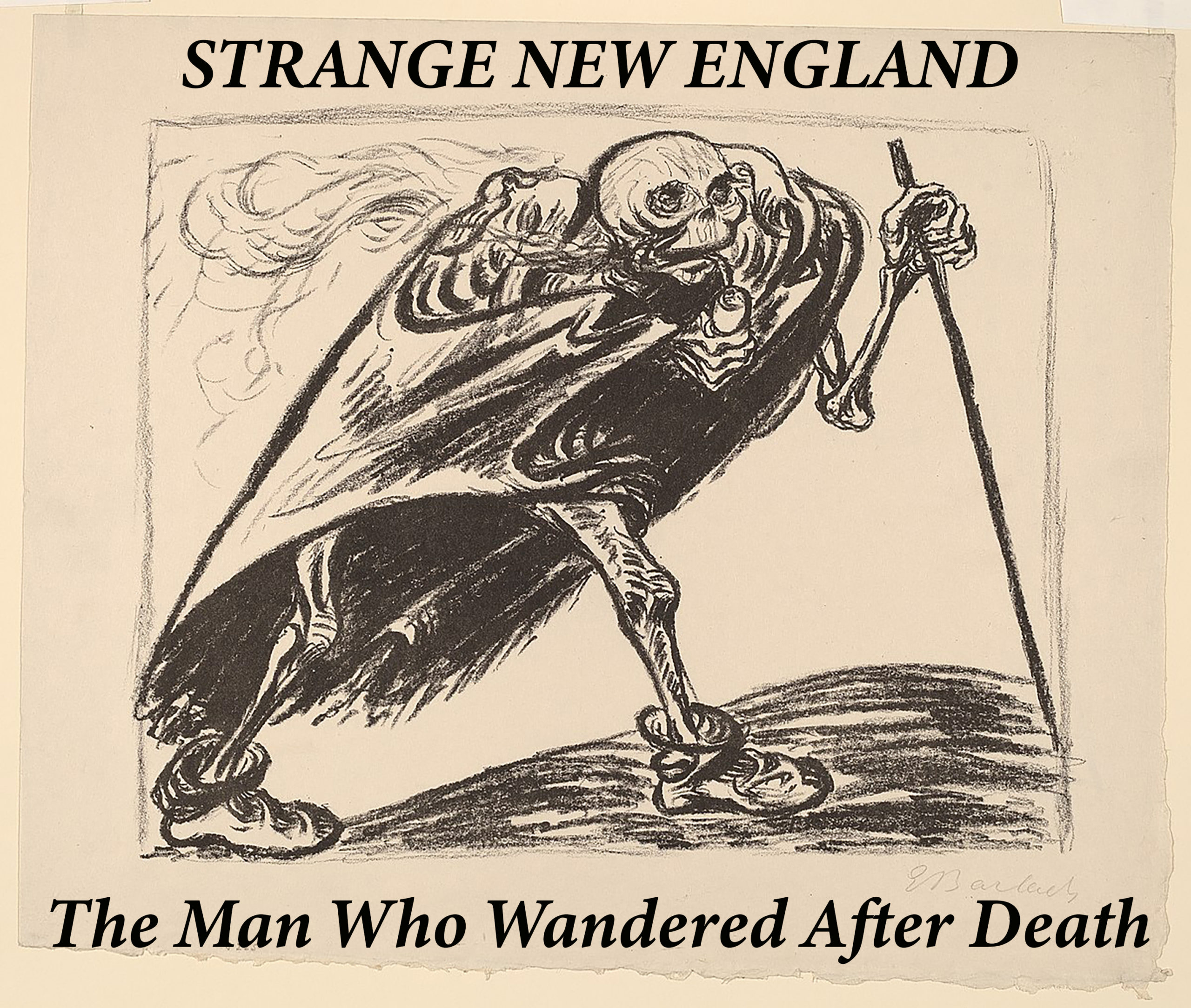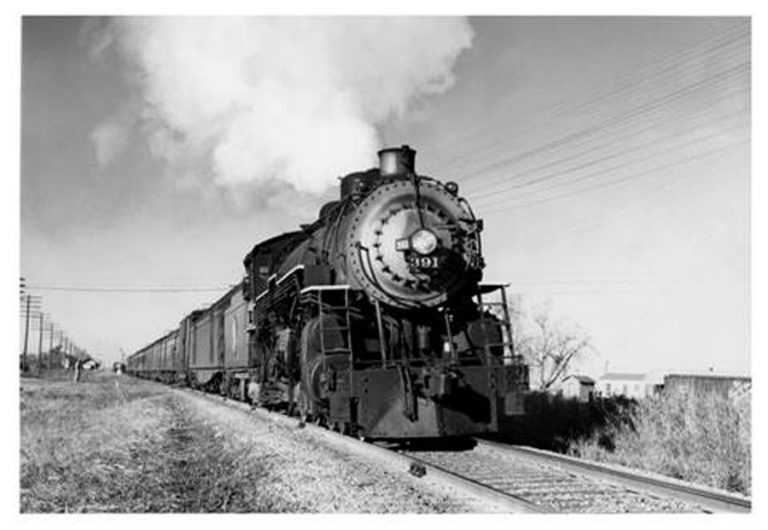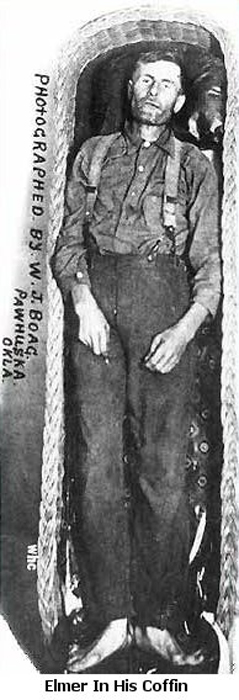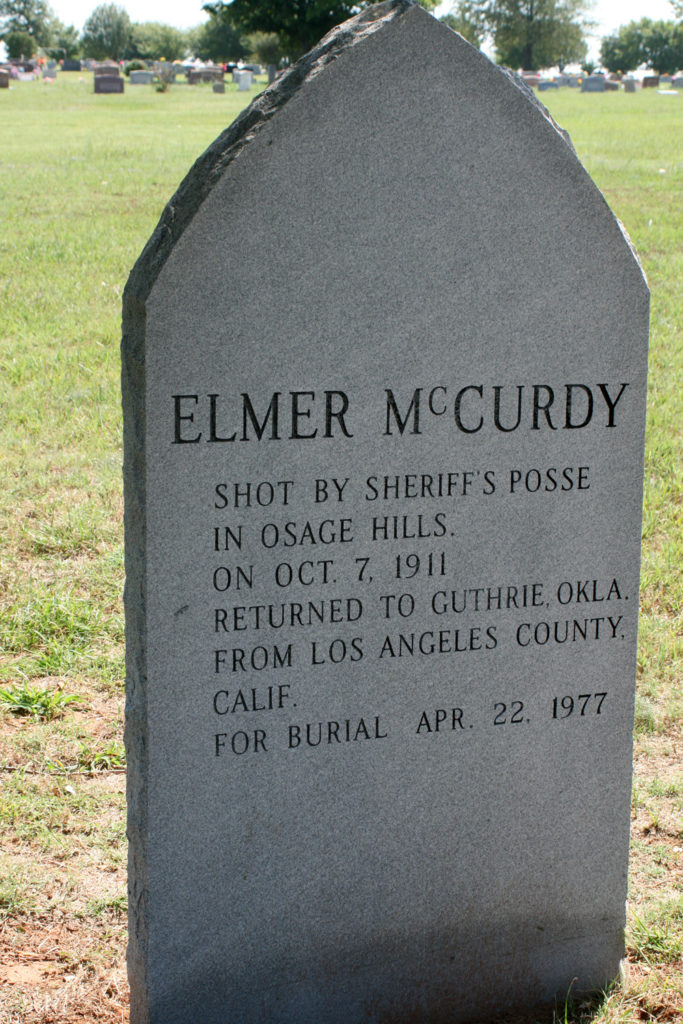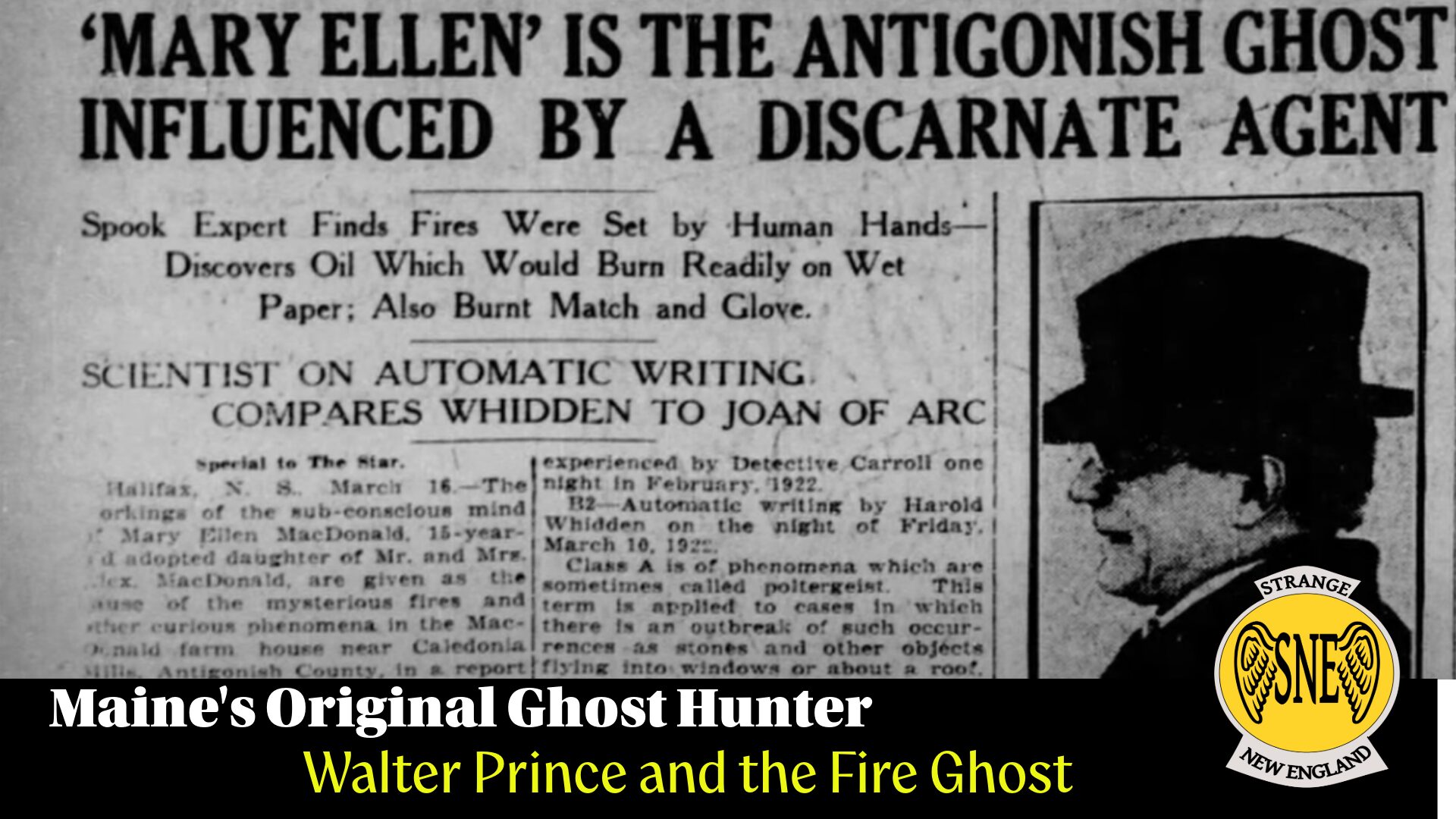
Three score years and ten. It says it in the Bible, our allotted time upon this planet, the time we can expect to wander and walk and wonder, because nobody lives forever. From dust we come and to dust we return and that is one of the great equalizers for all Humanity – in the end, we’re all the same. Well, most of us. The need for humans to forestall their deaths is understandable, because what comes next is perhaps the greatest mystery of all. Most of us can expect a final resting place for our remains, though more and more the trend is the scattering of ashes. As the poet said long ago, the grave’s a fine and private place, a little piece of real estate for eternity. But for some, their journey to that final destination is full of detours and winding ways. Take the story of Elmer McCurdy, late of Washington and Bangor,Maine.
Washington, Maine. Even today, the little village has a post office, a fire station, a general store and a bookstore. That’s about it. It has not changed much since 1880, when Elmer was born January 1, 1880 in Washington, Maine- a New Years’s baby – to 17 year old Sadie. His father was not in the picture nor did he ever know him, though it was rumored to be her cousin,Charles. In order to save his sister from the stigma and also to give little Elmer support, Sadie’s brother, George, adopted him. Sadie lived with George and his wife, Helen. So Elmer had a father for the first ten years of his life, someone to guide him. He was brought up to think that George was his natural father and Helen his natural mother and that Sadie was his spinster aunt. In 1890, when Elmer was ten years old, George succumbed to tuberculosis. With no one to support them, Sadie and Helen took Elmer and moved north to the bustling city of Bangor, alongside the Penobscot.
It was a working man’s town, a drinking man’s town with places no ten year old boy, especially without a father, should ever go, either in the daylight or after dark. By the time Elmer was a teenager he had discovered his true parentage. Elmer became a rebellious teenager, with no guidance in a town where beer and whiskey ran like water on nearly every street corner. It was during these formative years that Elmer became an alcoholic. Things went from bad to worse in Bangor. The fighting, the drinking and the lack of any focus in his life sent Elmer into a downward spiral that somehow, he found his way out of. When he had male guidance in his life, he had done well. When he had none, he fell hard from grace. To that end he reached out to his only other male relative, his grandfather who still lived in the town of Washington. There he learned the trade of a plumber. Away from the night life and rowdiness of Bangor and in the presence of his sober grandfather, their plumbing business thrived until 1898, when the economy took a downward turn.
His grandfather began to suffer from dropsy, hemorrhages, and other symptoms what would eventually be diagnosed as Bright’s Disease. He died from a ruptured ulcer. After a month of illness, Elmer found himself without a male force in his life to guide him. He was young, he had no connections, but he did have a trade. Why he left his trade for a life of villainy, we will never know.
Maine was too quiet a setting to hold the anger and rambunctiousness that Elmer had when on a tear. With no one to stop him, Elmer took to the bottle again and then, he took to the road. He went from job to job, rambling the country. He tried plumbing for awhile, but it lacked adventure, it lacked the excitement that he was craving, so he went west and tried his hand as a lead miner. Roaming from job to job and town to town, drinking along the way found his first real run-in with the law: he was arrested for public drunkenness in Kansas. As soon as he could, he left Kansas for Missouri.
Elmer must have wanted a better life. He must have longed for something better. Perhaps his recent run-ins with the law made him reconsider the course of his life. After seven years of struggle and uncertainty, drinking and rowdiness, in 1907 Elmer McCurdy joined the United States Army and was assigned to Fort Leavenworth. His assignment was that of machine gun operator, a weapon invented by fellow Maine native Hiram Maxim. Though he could operate a machine gun with great alacrity, he showed real promise with high explosives. He learned to handle and use nitroglycerin. For the three years of his enlistment, Elmer McCurdy became proficient at blowing things up. But the end of his term came in November 1910. Had he stayed in the Army, Elmer might have made older bones. As things panned out, Elmer would be dead in less than twelve months.
Elmer found himself at sixes and seven, unable or unwilling to settle down to a simple life. He took again to rambling from town to town, eventually winding up with an army buddy in Kansas where they were both arrested for possession of the tools of a thief. They were tried and at their trial, McCurdy and his friend insisted to the judge that they needed the blackpowder, hammers, chisels and saws because they were endeavoring to invent a foot-operated machine gun. A sympathetic judge found the pair not guilty and Elmer McCurdy found himself a free man when he was released just after he turned thirty one years of age.
Elmer was released back to the world without a direction or a plan. He took to wandering again, this time to Oklahoma where he heard rumors of a safe being transported that contained a lot of money, perhaps as much as four thousand dollars. It was supposed to be on the Iron Mountain-Missouri Pacific Train. A daring act of boldness and some nitroglycerine could do the trick. With the help of three other men, he gave it a shot. The result was disastrous – he miscalculated the amount of nitro needed and blew up the safe so totally that any paper money that might have been inside was incinerated. He managed to haul away a hunk of silver coins that had fused together, equalling about $450 for their troubles.
Having escaped and absconded with the silver, McCurdy turned his hand to bank robbing. Chautauqua, Kansas offered a tempting target – the Citizens Bank. With the help of two new scoundrels, Elmer took more care not to blow the safe to Kingdom Come with his nitroglycerin. But Elmer’s luck was beginning to show a pattern toward the unfortunate. His first attempt destroyed only the outer door of the vault. Another secondary charge didn’t even explode. Elmer and his accomplices found some bags of coins left outside the main vault and left with a pitiful amount given their efforts – around $150, again, in coins. He was turning out to be a successful coin thief, and that was it.
On the run again, Elmer split up from his two accomplices and found himself living in a hay barn on a ranch in Oklahoma. Tired, sick and depending heavily on drink, Elmer heard of another chance to prove himself as a skilled thief. The Osage Nation was to receive a royalty payment of $400,000, a tempting target for a man on the run with nothing to lose. He easily found two other men to help him. The trio successfully stopped the train and searched it frantically for the money, but it became clear very quickly to them that they had, in fact, stopped the wrong train. They robbed the passengers taking whatever they had, including $46 and some whiskey. Another failed attempted – the worst one yet.
Elmer McCurdy went back to the farm where he had been staying in Oklahoma. He was sick, probably with pneumonia and tuberculosis, a dire condition indeed, especially when living in a hay barn. What little luck he had was running out. A $2000 reward was offered for his apprehension, something he was unaware of in his quiet hideout. On the morning of October 7, 1911, the farm was visited by a deputation of three Sheriffs who had tracked McCurdy with bloodhounds. McCurdy put up a fight but in the end, a sheriff’s bullet pierced his chest and the last day of a bad man ended. Elmer McCurdy from Washington,Maine, plumber, alcoholic, train and bank robber and criminal failure, was done. It was over.
But not really. In a way, Elmer’s journey had only just begun…
Since he was brought in dead, and not alive, there was no need for a trial. The body was brought to the local undertaker in Pawhuska, Oklahoma, who, after the manner of his occupation, embalmed Elmer’s corpse with embalming fluid infused with arsenic, to preserve it for whatever journey it would need to take to make it to his final burying ground. Little did he know how long that journey would be.
Imagine being the undertaker waiting for days, then weeks, without anyone showing up to claim the body. After six months, it became clear to the undertaker that he was going to take a loss on this cadaver, so he stuck a pistol in Elmer’s hand and charged folks a nickel to see the infamous train robber, Elmer McCurdy. People came from miles around and soon word spread – not only could you see a preserved dead body but it was that of an outlaw! For five years, the attraction continued until one day, two men showed up claiming to be Elmer’s kin. They paid the undertaker and left with the corpse. Of course, they weren’t his kin and of course, they weren’t about to bury a moneymaker.
The two mysterious ‘relatives’ were actually owners of a traveling carnival. From 1916 to 1922, Elmer’s corpse kept roaming from town to town. In 1922 he was sold to a man who had a wax museum. Elmer was put in the outlaw section but was touted as a ‘real dead outlaw’. His corpse remained there 49 years until it was sold again and went on display in a California fun park, displayed as the Thousand year old man. He was hung from the neck in a ghost train ride, painted in phosphorous paint to glow in the dark.
The fun park , known as The Great Patterson Shows, was rented in 1971 for an episode of The Six Million Dollar Man. The props man, Chris Haynes, noticed that the dummy hanging from its neck looked too real. He was trying to move the thousand year old glow-in-the-dark man from his noose, when Elmer’s arm fell off, revealing his bones.
Haynes tell us the following: ” It was easy to see his body stitched up from his autopsy. Elmer’s hands were covering his private parts. I tried to move the hand to show them that he … wasn’t made from papier maché. When I moved his arm, it snapped off in my hand, exposing bone and mummified muscles. I reported this to the Long Beach cop working on the show.”
After a rather lengthy investigation and following the paper trail, the authorities discovered who this unlikely carnival attraction really was. They pried open his mouth and found a 1924 penny and a ticket from the Museum of Crime in LA. They found the .32 caliber gunshot wound and the bullet that killed him – manufactured somewhere between 1830 and 1920. Eventually, newspaper accounts helped them discover the identity of the cadaver: none other than Elmer McCurdy, formerly of Washington and Bangor, Maine, plumber, train and bank robber.
They buried his bones in April of 1977 in the Boot Hill section of the Summit View Cemetery, in Guthrie, Oklahoma. They covered the coffin in concrete before they piled the dirt back on. After all of his rambling and nefarious deeds, his suffering and death, Elmer McCurdy is finally at rest.
When you step out of your door as your leave your house, you never truly know when you’re ever going to come back again, if at all. Not a very comforting thought. You might find a vast journey ahead of you, or maybe just a trip to market, before you make it home again. In the case of Elmer McCurdy, he might have gone on to meet his maker in 1922 but his body kept on moving from town to town, for all to see, without ever knowing the truth of his identity or the sad turns his life took before he met with the bullet that robbed him of his breath.
SOURCES
Images – in the Public Domain
Cover Art – “Wandering Death” by Ernst Barlach, commons.wikimedia.org
Aulenbacher, Carrie. “The 97 year journey of 31 year old bank robber, Elmer McCurdy.” Western Magazine, Aug 29 2021. https://www.westernmagazinedigest.com/2021/08/the-97-year-journey-of-31-year-old-bank.html
Aulenbacher, Carrie. “Elmer McCurdy, Part Two.” Western Magazine, Sep 12 2021.
https://www.westernmagazinedigest.com/2021/09/elmer-mccurdy-part-two.html
Chronicle Live. 2013. “Why Elmer McCurdy will never be a dead loss.” Jun 1 2001. Updated Feb 28 2013.
https://www.chroniclelive.co.uk/whats-on/theatre-news/elmer-mccurdy-never-dead-loss-1681906
Readman, Kurt. “Elmer McCurdy, America’s Bizarre Sideshow Corpse” Historic Mysteries.
https://www.historicmysteries.com/elmer-mccurdy/?fbclid=IwAR3TfJjN8IVuEh9ETFXeyT-Gw5JN0qU7PG64FR9CP07uodeiJ9S_aN_OTFU
Deem, J.M. Elmer McCurdy, “The Trainrobber Who Became a Mummy.” How to Make a Mummy, Houghton Mifflin, 1995.
https://jamesmdeem.com/stories.mummy.mccurdy.html
Human Marvels. “ELMER MCCURDY – THE WANDERING DEAD” 2021.
https://www.thehumanmarvels.com/elmer-mccurdy-the-wandering-dead/
Meier, A. “The Mummy Everyone Forgot Was Real”.2013.
https://www.atlasobscura.com/articles/31-days-of-halloween-day-1-elmer-mccurdy
Npr. “The Long, Strange, 60-Year Trip of Elmer McCurdy”.2015.
https://www.npr.org/2015/01/09/376097471/the-long-strange-60-year-trip-of-elmer-mccurdy?t=1632159020386
Souerbry, R. “The Strange Story Of Elmer McCurdy – The Outlaw Whose Body Became A Film Prop”. 2019.
Find a Grave – Elmer McCurdy
https://www.findagrave.com/memorial/1706/elmer-mccurdyhttps://www.findagrave.com/memorial/1706/elmer-mccurdy
